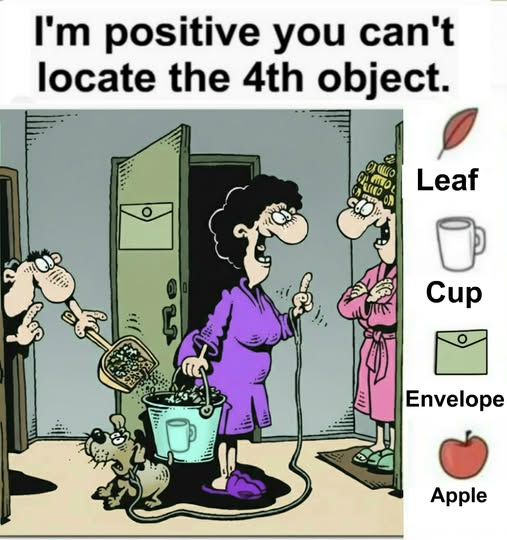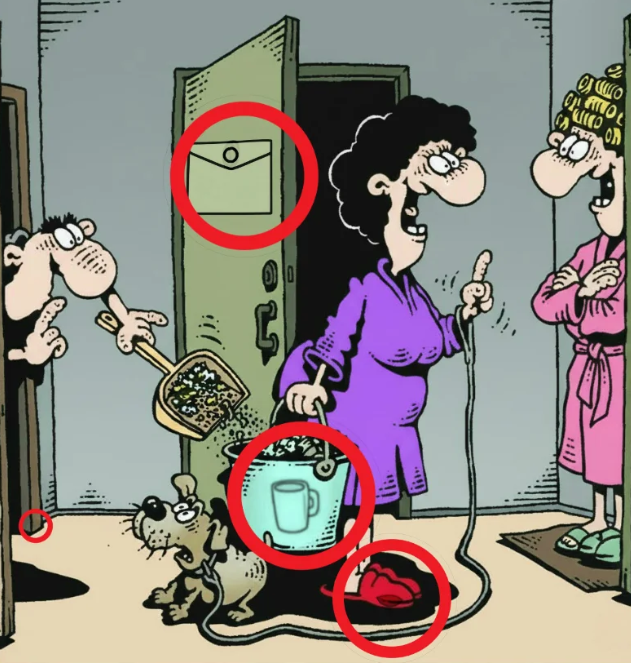Welcome to the 4-Object Search Challenge
Ready to test your attention to detail? In today’s visual puzzle, your mission is simple on paper but sneaky in practice: spot a leaf, a cup, an envelope, and an apple hidden in a lively cartoon scene. Don’t scroll too fast—give yourself a minute to hunt. Where would you look first? Near the floor? On the walls? Inside containers? Tell me how you’d approach it, and how long it takes you to find all four. Friendly bragging rights are absolutely encouraged.
Why This Kind of Puzzle Trips Up Smart People
These seek-and-find challenges are less about eyesight and more about how your brain edits reality. A few common traps:

- Center bias. We instinctively search the middle of an image and miss clues tucked along edges, skirting boards, or door frames.
- Object assumptions. We expect a cup to sit on a table, an apple to rest in a bowl, and an envelope to lie on a desk. When the objects live in odd places, our mental model rejects them.
- Camouflage and scale. Artists often match color and size to the background—tiny objects fade into flooring, paint, or shadows.
- Occlusion. Parts of the scene overlap, so an object appears only partially: half buried, half covered, or nested inside something else.
- Confirmation bias. Once you “decide” what a shape is—say, a slipper—you stop questioning it, even if it’s actually an apple in disguise.
Sound familiar? Great—now let’s build a method that sidesteps those traps.
A Step-By-Step Method That Works
Use this repeatable system for any hidden-object puzzle:
- Work the perimeter first. Scan along the walls, baseboards, ceilings, door edges, and floor line before diving into the center.
- Sweep in rows. Move your gaze left to right, then down one “row,” like reading lines of text. This reduces skipped zones.
- Check “containers” and overlaps. Buckets, pockets, boxes, and even sleeves often hide smaller items. Look inside and behind.
- Hunt for silhouettes. Forget color for a moment. Ask, “Where do I see the outline of a leaf, a cup handle, an envelope flap, or a rounded apple?”
- Question the obvious. When something looks like a slipper or wall plaque, quickly test alternative identities.
- Verify with contrast. Toggle your focus between bright and dull regions; objects often pop when you mentally “squint” at contrast and simple shapes.
Video : I Bet You Can’t Find the 4th Object 😱
Keep that framework in mind as we walk through this specific scene together.
Guided Walkthrough: Find Each Object
Let’s apply the method step by step.
- Leaf
Start with the perimeter sweep along the floor line. Trace the area near the door threshold and the skirting board. You’ll notice a small leaf on the floor near the door, slightly blending into the beige ground. It’s easy to miss because it’s tiny and the color echoes the floor tone. Pause, confirm the small serrated outline, and lock it in—leaf found. - Cup
Now scan for containers. The woman in the purple robe holds a bucket full of cleaning supplies. Peer inside the bucket rather than at its rim. Nestled among suds and tools sits a cup—a simple mug profile with a handle. Many solvers skip this because they only glance at the bucket as a single object; remember, containers love to hide cargo. - Envelope
Next, follow the walls and door. On the inner side of the open door, there’s a rectangular shape with a triangular flap and a small closure dot—classic envelope geometry. The envelope is attached to the door, masquerading as a wall notice. The shape cues (rectangle + V-flap) are the giveaway; color similarity with the door makes it stealthy. - Apple
Finally, sweep the floor again—this time question “obvious” items. Near the woman’s feet you’ll see a bright red, rounded shape. Your brain may label it as a slipper at first glance because it sits by footwear. But the contour and shine say otherwise. That red object is the apple, tucked beneath the woman’s foot, partly occluded by the vacuum hose. Re-frame it from “shoe” to “fruit,” and the highlight and curve suddenly make perfect sense.
Why You Might Have Missed Them
- The leaf blends by color and size; our eyes prioritize faces and large objects, not tiny ground details.
- The cup hides in plain sight thanks to nesting—people treat the bucket as a single unit and don’t probe inside.
- The envelope tricks you through context; a door sign feels normal, so you don’t re-interpret it as stationary.
- The apple leverages occlusion and association with shoes; the red hue reads like a fuzzy slipper until you inspect its glossy curve.

Knowing these pitfalls helps you solve future puzzles faster. When something seems “normal,” ask for a second opinion—from yourself.
Speed Tips to Sharpen Your Visual Logic
- Label as you go. Whisper the item names—leaf, cup, envelope, apple—while scanning. It primes the pattern detector in your brain.
- Zoom with your eyes. Alternate wide sweeps with micro-inspections of suspicious clusters (buckets, pockets, shelves).
- Search by icon, not detail. Think of minimalist icons: a leaf’s serration, a cup’s handle, an envelope’s V-flap, an apple’s roundness.
- Use the “rule of edges.” Artists hide 30–50% of surprises within two finger-widths of an edge—door frames, baseboards, borders.
- Time-box your scan. Give yourself 60–90 seconds before peeking at hints; speed forces you to rely on structure, not luck.
- Reverse assumptions. If an object looks like A, ask “How could it be B?” That mental toggle exposes camouflaged answers.
Your Turn: Share Your Strategy
How long did it take you to spot all four? Which one stalled you—the envelope on the door or the apple by the foot? Drop your time, your order of finds, and your best tip in the comments. If you’re playing with friends or family, screenshot the puzzle and see who finishes first. Bonus challenge: describe your search route (perimeter first or center first?) and compare results.
Final Answers Recap
- Leaf: on the floor near the door threshold.
- Cup: inside the bucket the woman is holding.
- Envelope: mounted on the door.
- Apple: under the woman’s foot on the floor.
Video ; I bet $15,000 you Cant find the 4th Object! Hard
Keep the Momentum Going
If you enjoyed this hunt, try three more today using the same method. The more you practice, the sharper your selective attention, pattern recognition, and logic under time pressure become. These aren’t just party tricks; they translate to everyday skills—spotting critical details in emails, catching inconsistencies in reports, or noticing hazards on the road.
You’ve flexed your focus, questioned assumptions, and uncovered four cleverly hidden objects. Now pass it on: share your results, challenge a friend, and keep training your brain. The next puzzle is waiting—and you’re already faster than you were five minutes ago.